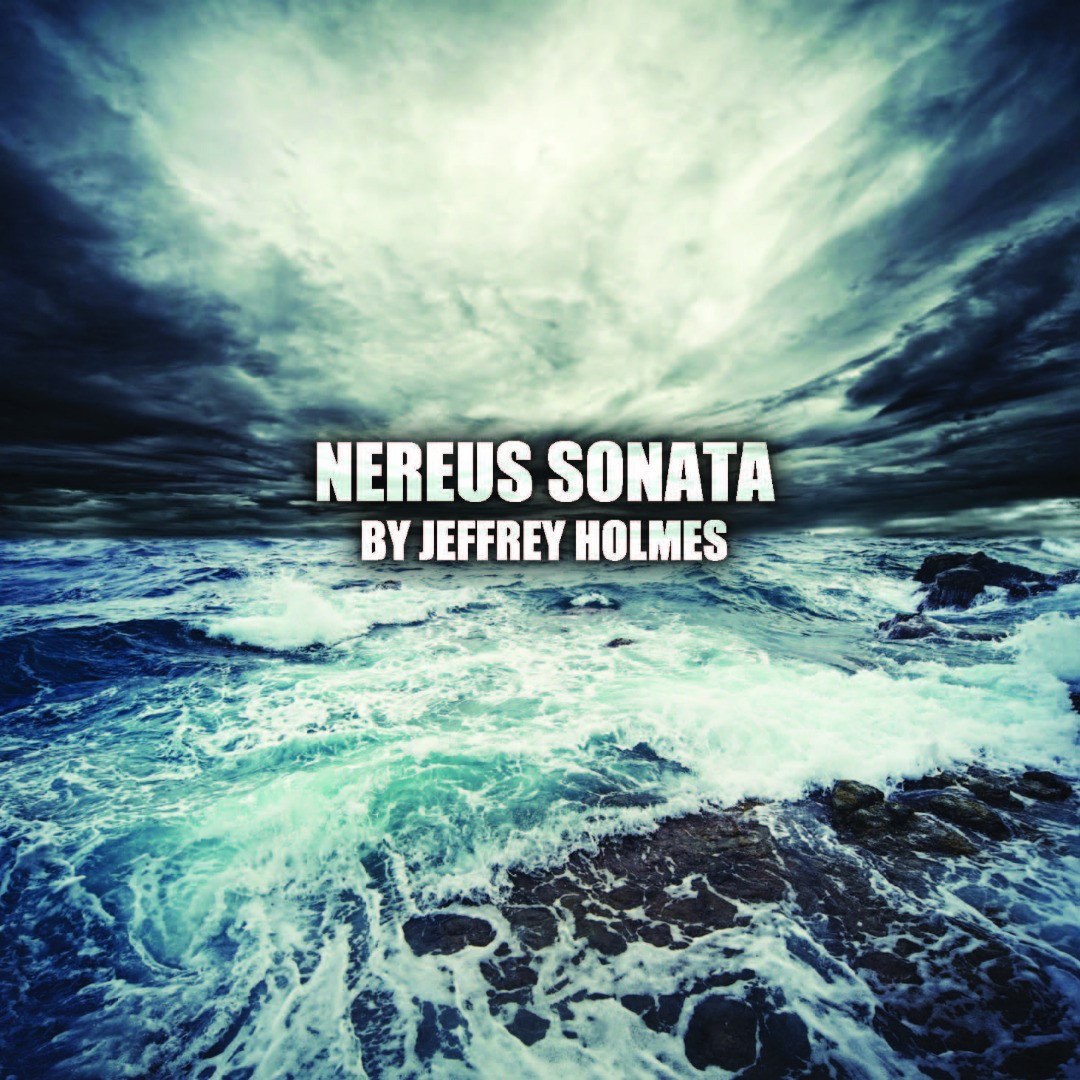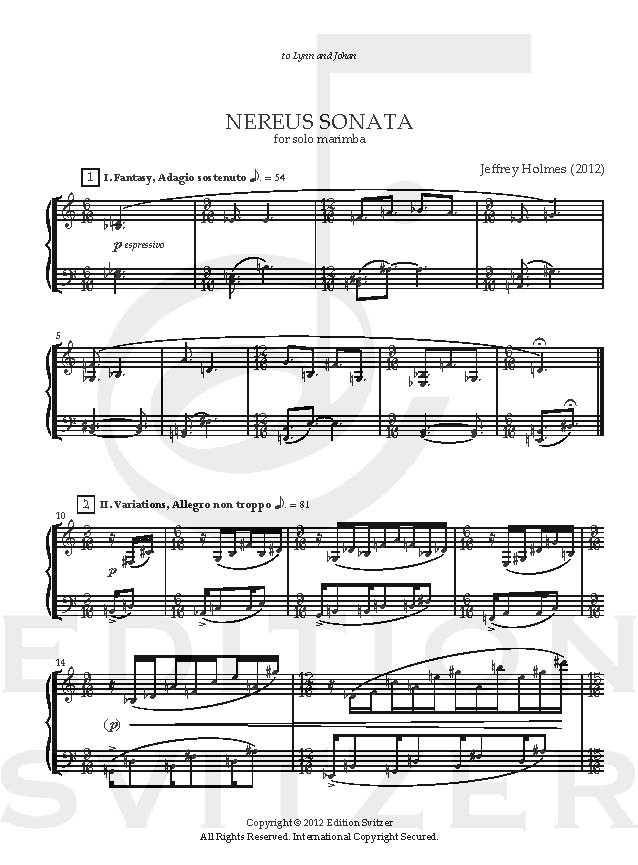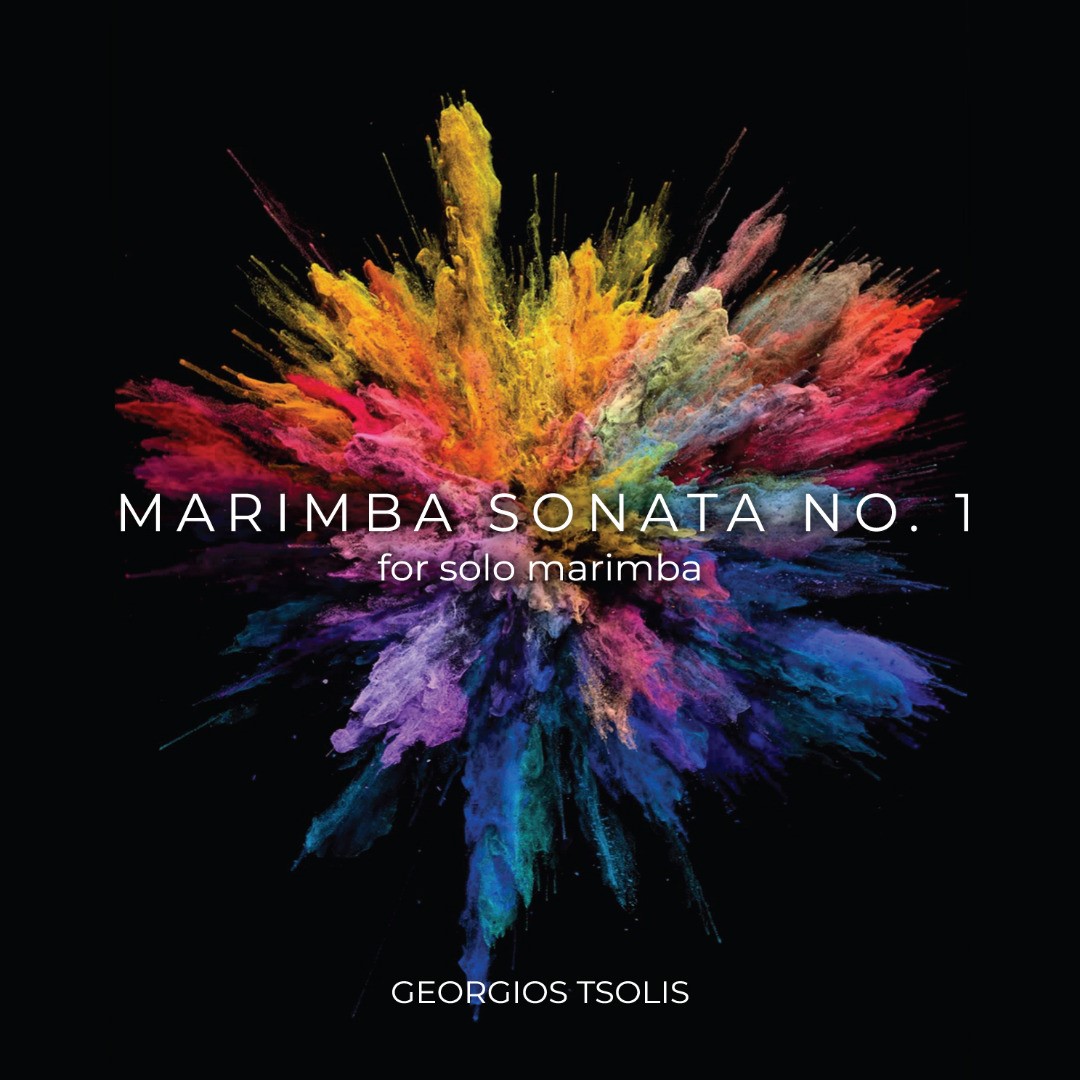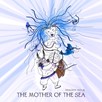
Nereus Sonata
Composer: Jeffrey Holmes
Instrument: Marimba
Level: Advanced
Published: 2012
Price: €20.00
Item details
-
Description +
-
Duration: 10 min.
The Nereus Sonata, for marimba, was composed in the February of 2012. The title, Nereus is from Greek mythology, and is the name of the God of the sea. I chose his name for this Sonata as a celebration of my long-awaited recent return to living near the ocean. There are several references to waves and the sea: the Fantasy that is the basic material for the whole piece features a ‘sinking’ harmonic progression, many of the variations are layered in water inspired textures, the episodes in the fugue are clear wave-like shapes, and in the layering of the circular fugue subject that is itself shaped like waves, as well as in the impressionistic cadenza near the end of the work…therein lies a slow, tricking passage that is reminiscent of water receding down the seashore and back into the ocean from which it came. Actually, while composing this work, I imaging the marimbas uniquely resonant qualities to be a sunken, submerged piano, with somewhat muted reverberations. The connection to the Greek myth manifests in that all the basic material is derived from a Phrygian scale (but all within my own ‘multi-tonal’ chromatic language). Overall this work portrays the joy of the sea, not the rage that I have painted in many of my other compositions, and is a vast, constantly varied, landscape of sound.
-
-
Instrumentation +
-
Marimba (5-octave)
-
-
About the composer +
-
The music of composer Jeffrey Holmes has been called “Captivating…haunting and slightly disorienting” by the Los Angeles Times, “Drifting… ethereal” by the San Francisco Classical Voice, and “Interesting and musically arresting, music to be really heard and deserving of reflection” by the Society of Composers, INC. As a traditionalist, he composes music for acoustic orchestral instruments, using standard notational methods; as a formalist, he works within a complex and unique diatonic, chromatic, and microtonal language; as a transcendentalist, he combines the inherent abstraction of sound with a greater meaning and possibility of interpretation through the use of lyricism and overt expression.
His music has been performed at festivals such as the Darmstadt Ferienkurs für Neue Musik (Germany), La Pietra Forum for New Music (Florence, Italy), at “Microfest” (2003, 2005, and 2011) and both the “HEAR NOW” and “What’s Next?” festivals (Los Angeles), and in venues including Carnegie Hall (New York), the Historic Dvorak Museum (Prague, Czech Republic), and the Chapelle historique de Bon- Pasteur (Montreal, Canada). He has received commissions and performances from groups including the Penderecki String Quartet, Bass-baritone Nicholas Isherwood (Germany), ECCE (East Coast Contemporary Ensemble), “Duo Resonances” – France (Frédérique Luzy and Pierre Bibault), Piano Spheres, the Eclipse String Quartet, Trio Terroir, California Institute of the Arts Orchestra, USC Thornton Symphony, Xtet, Inauthentica, the Los Angeles Percussion Quartet, and others.
He holds a doctorate in music composition from the University of Southern California, and has studied with composers such as Georg Friedrich Haas, Donald Crockett and Stephen Hartke. Currently, he is Assistant Professor of Composition and Theory at Chapman University. His music is published by Edition Svitzer (Copenhagen, Denmark) and Doberman-Yppan (Quebec, Canada), and has been recorded on the Sono Luminus label, distributed worldwide by Naxos.
-
-
Reviews +
-
Review (Percussive Notes, May 2013)
Jeffrey Holmes has established himself as an up-and-coming composer of 20th century music, and this work very much fits that mold with the use of everchanging time signatures, modal mixture, and polyrhythmic playing.
Upon first glance, the multiple compound time signatures coupled with the lack of a key signature is a bit daunting. Holmes, however, takes every precaution to ensure all of his notes are clearly marked with naturals, flats, or sharps, sometimes all three within the same measure. There are instances of enharmonic pitches (D-sharp and E-flat) being used in the same measure, the same beat, and even within the same chord, which is a little frustrating when learning the piece.
The term “sonata” suggests a particular form of composition, to which this piece only loosely adheres. More closely resembling a theme-and-variations of sorts, intensity builds throughout each variation (after a simply stated central theme) with the right hand maneuvering some tricky intervals under an oftentimes pulsating left hand, which drives the piece both rhythmically and harmonically. Cascading lines emote an ethereal “waterfall-esque” feeling as referenced by the title of the composition.
The fugue that is introduced in the middle of the piece features a more lyrical, almost rhapsodic style of playing than the first section. The addition of multiple metric accelerants (4:3, 5:3, etc.) gives this section a free, almost rubato feel, although strict metric time is notated. Again, this harkens back to the unpredictability of water referenced above. Holmes craftily develops his melodic material into an exciting flourish, which leads to the cadenza and subsequent “Fantasy, Adagio sostenuto” bringing the piece to a soft, quiet ending, reminiscent of the opening theme.
You will need to have quite a “wingspan” to perform this piece, as at one point during the composition the performer is expected to play octave E-flats four octaves apart. This piece is full of polyrhythms, each a bit more difficult as the composition develops. The cadenza itself is virtually all polyrhythmic playing. Suffice it to say, a strong understanding of polyrhythms is a must for any student or professional looking to play this piece.
Overall, this is a challenging piece on many levels. The notation is very clear, but with the lack of a tonal center would be, at times, difficult to navigate and subsequently memorize. Anyone looking percussive notes 62 MAY 2013 for the challenge of seamlessly playing multiple polyrhythms in an avant-garde style should give this one a try.
—Marcus D. Reddick
-
-
Credits +
-
Front Cover graphics and layout: Ronni Kot Wenzell
Engraving: Jeffrey Holmes & Johan Svitzer
Printed in Copenhagen, Denmark
Copyright © Edition SVITZER
www.editionsvitzer.com
-





